Human Orbital Spaceflights
![]()
International Flight No. 83STS-4Columbia (4)4th Space Shuttle missionUSA |
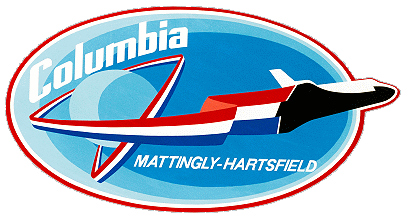 |
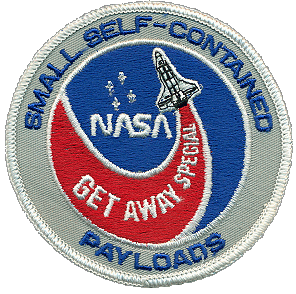 |
![]()
Launch, orbit and landing data
walkout photo |
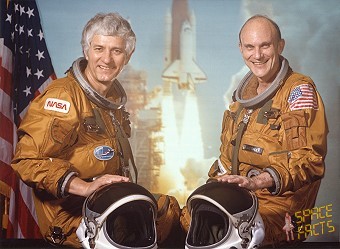 |
||||||||||||||||||||||||||||
alternative crew photo |
|||||||||||||||||||||||||||||
alternative crew photo |
Crew
| No. | Surname | Given names | Position | Flight No. | Duration | Orbits | |
| 1 | Mattingly | Thomas Kenneth II "Ken" | CDR, EV-1, RMS | 2 | 7d 01h 09m 41s | 113 | |
| 2 | Hartsfield | Henry Warren, Jr. "Hank" | PLT, RMS | 1 | 7d 01h 09m 41s | 113 |
Crew seating arrangement
|
 |
|
||||||||||||
Hardware
| Orbiter : | OV-102 (4.) |
| SSME (1 / 2 / 3): | 2007 (4.) / 2006 (4.) / 2005 (4.) |
| SRB: | A13/14 |
| ET: | ET-4 (SWT-4) |
| OMS Pod: | Left Pod 02 - LV 01 (4.) / Right Pod 02 - RV 01 (4.) |
| FWD RCS Pod: | FRC 2 (4.) |
| RMS: | 201 (3.) |
| EMU: | EMU No. 1019 (PLSS No. 1006) / EMU No. 1016 (PLSS No. 1005) |
Flight
|
Launch from Cape Canaveral (KSC) and
landing on the Edwards
AFB, Runway
22. STS-4 marked the fourth and final development flight of the Space Shuttle and the first Shuttle flight with a Department of Defense payload. One of the main goals was the test of the "Remote Manipulator Arm", seizing an Equipment and lifted it from the cargo of the shuttle. The box of the IECM experiment (Induced Environment Contamination monitor), designed to obtain information on gases or particles being released by the orbiter in flight. This mission carried out the first commercial experiment involving Continuous Flow Electrophoresis System (CFES). The cargo included the first Get Away Specials (G-001), which contained nine experiments from Utah State University. The crew took data for two medical experiments on themselves for two student objects. The Induced Environment Contamination Monitor (IECM) was a desk-sized detector containing 10 instruments for contaminants in and around the Space Shuttle orbiter cargo bay which might adversely affect delicate experiments being carried aboard. The on-orbit measurements included molecular return flux, background spectral intensity, molecular deposition and optical surface effects. During the other mission phases, dew point, humidity, aerosol content and trace gas were measured, as well as optical surface effects and molecular deposition. The detector operated attached to a release mechanism on the Development Flight Instrumentation pallet during the second Shuttle mission, but on the third and fourth flights it will be moved around and outside the cargo bay by the orbiter's Remote Manipulator System and then reattached. On Spacelab missions one and two, it will be attached to the Spacelab pallet. The Monodisperse Latex Reactor was a materials processing in space experiment, first carried out on STS-3, designed to study the feasibility of making monodisperse (identical size) polystyrene latex microspheres in space. The project was developed at NASA's Marshall Space Flight Center and Lehigh University in Bethlehem, Pa. The experiment consisted of four, 0.3-meter (1-foot)-tall reactors, each containing a chemical latex-forming recipe, housed in a 0.6-m (2-ft.)-tall metal cylinder. The recipe was a suspension of very tiny latex beads in water or another liquid. Latex spheres produced on the third Shuttle mission will be among the seed particles used to grow larger spheres on the fourth flight. On Earth, the beads can be produced only up to about three microns and still be monodisperse. The experiment which was flown on a total of four flights helped determine if much larger (larger than 20 microns) monodisperse beads can be produced practically and economically in space. These latex particles may have major medical and industrial research applications. Some of the proposed applications of the latex beads include measuring the size of pores in the wall of the intestine in cancer research; measuring the size of pores in the human eye in glaucoma research; and as a carrier of drugs and radioactive isotopes for treatment of cancerous tumors. The Nighttime/Daytime Optical Survey of Lightning experiment, developed and managed by NASA's Marshall Space Flight Center recorded motion pictures and photo cell readings of lightning and thunderstorms as seen from orbit. The data and knowledge were expected to result from the lightning survey may lead to the development of a better understanding of the evolution of lightning in severe storms. The experiment, which was scheduled to also be carried aboard STS-6, was first flown on the second Shuttle flight (STS-2) but, due to the shortened flight, produced limited results. Lightning discharges were sensed by the photo-optical system, which creates an electronic pulse in response to the detection of a lightning flash. These pulses were recorded on magnetic tape. A lightning event, which is visible as only one flash, is usually composed of many separate discharges, or strokes, which are detected by the photocell. Thus, the photocell was also used during the night to record lightning strokes. And the motion picture camera was used during the day as well to film the cloud structure and the convective circulation in the storm. These techniques may be adaptable in the development of sensors to identify severe weather situations from future meteorological satellites. The Continuous Flow Electrophoresis System, nicknamed "Eos" (Greek god of the dawn) by its developer, the McDonnell Douglas Astronautics Co., St. Louis, Mo., was designed to separate biological materials according to their surface electrical charge as they pass through an electric field. Unlike previous electrophoresis experiments in space, the system processes considerable quantities of materials carried in a continuous stream. This flight is an initial engineering test of the electrophoresis system hardware and will process six McDonnell Douglas protein samples. Gravity limits the concentration of the materials in the sample being separated, which is one of the primary factors limiting the electrophoresis production of commercial quantities on Earth. On Earth, only 0.25 percent of the sample to be separated can be biological material. The rest must be carrier fluid. In space, however, the concentration can be increased to 20 percent or more of the total sample, which increases the output of the process by a factor of 80 to 100 over Earth processing. As part of the OAST program several more experiments were carried out. The primary objectives of the Aerodynamic Coefficient Identification Package (ACIP) were to collect aerodynamic data during the launch, entry and landing phases of the Shuttle, to establish an extensive aerodynamic data base for verification of and correlation with ground-based data, including assessments of the uncertainties of such data and to provide flight dynamics data in support of other technology areas, such as aerothermal and structural dynamics. The Infrared Imagery of Shuttle (IRIS) experiment obtained high-resolution infrared imagery of the orbiter lower (windward) and side surfaces during reentry from which surface temperatures and hence aerodynamic heating may be inferred. The imagery obtained utilizing a 91.5-cm (36-in.) telescope mounted in the NASA C-141 Gerard P. Kuiper Airborne observatory positioned appropriately at an altitude of 13,700 m (45,000 ft.) along the entry ground track of the orbiter. A single image was obtained during each flight. Tile Gap Heating Effects (TGH) Experiment: The orbiter was instrumented with a removable panel 45.7 cm (18 in.) square, which will carry 11 tiles of baseline material and size. The panel was fitted to the underside of the orbiter fuselage. The gaps between tiles were be carefully calculated and controlled during fitting to ensure that the heating rates generated during entry will be no higher than those of the baseline tile array. The Catalytic Surface Effects (CSE) experiment investigated the chemical reaction caused by impingement of atomic oxygen on the Shuttle thermal protection system which was designed under the assumption that the atomic oxygen would recombine at the thermal protection system wall. The classified Air Force payload was the apparatus "DOD 82-1" of two missile launch-detection systems. This payload remained the whole mission in the payload bay. The payload failed to operate. A secret mission control center in Sunnyvale, California participated in monitoring the flight. The crew conducted a lightning survey with hand-held cameras, and performed medical experiments on themselves for two student projects. They also operated the Remote Manipulator System with an instrument called the Induced Environment Contamination Monitor mounted on its end, designed to obtain information on gases or particles being released by the orbiter in flight. The astronauts continued in testing the Canadian-built robot arm. Designed as an analog to the human arm, the Canadarm has shoulder, elbow and wrist joints driven by DC electric motors controlled by the flight crew using a combination of direct visual observation and television cameras on the elbow and wrist joints. The arm may be operated in five different modes ranging from full manual to computer-controlled through hand controls and keyboard at the payload station on the flight deck. The manipulator system was installed on the left payload bay longeron for STS-4. A second one can be installed on the right longeron for specific payload tasks, although both arms could not be operated simultaneously. The arm, built of a light-weight carbon composite tubing 38 cm (15 in.) in diameter, is 15.3 m (50.25 ft.) long, and weighs 408 kg (900 lb.). A thermal blanket provides temperature control for protecting joint-drive mechanisms and electronics. Brushless electric motors and gear trains drive the joints for pitch up/ down, yaw left/right and wrist roll motions. The "hand", called an end effector, has snare wires that engage a grapple fixture on the payload. Television cameras at the wrist and elbow provide the operator visual cues for maneuvering the end effector toward a grapple fixture or other target. Operator hand controllers are similar to those used for spacecraft maneuvers - a rotational hand controller for roll, pitch and yaw motions, and translational hand controller for up/down, left/right and fore/aft motions. When deactivated, the arm is latched into three cradle pedestals along the left longeron. If the drive mechanisms jam and the arm cannot be moved to its stowed position, and if contingency spacewalks are unsuccessful in restowing, the arm can be amputated with a pyrotechnic device. After this flight, Columbia's ejection seats were deactivated and shuttle crews would not wear pressure suits again until STS-26 in 1988. |
Photos / Graphics
 |
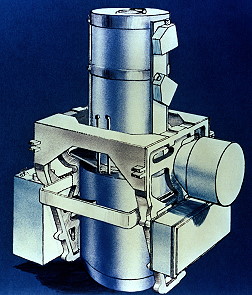 |
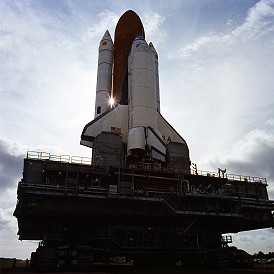 |
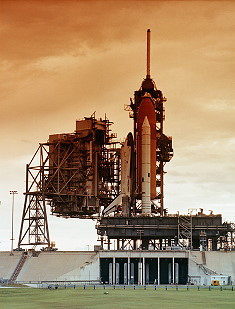 |
 |
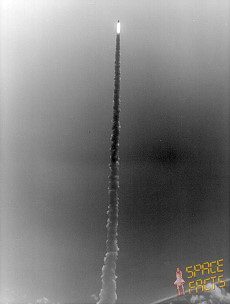 |
 |
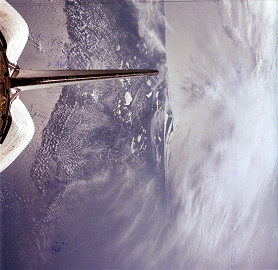 |
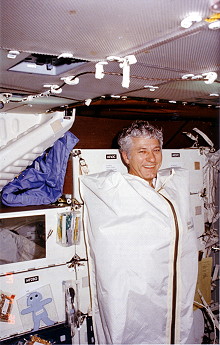 |
 |
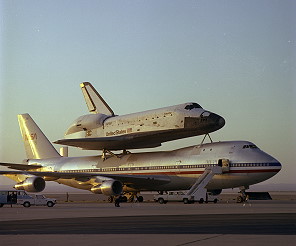 |
| © |  |
Last update on March 26, 2020.  |
 |